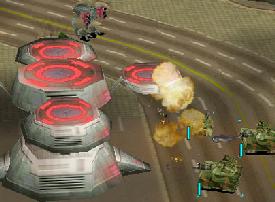> HOW ABOUT A NICE
GAME OF CHESS?
Back in the 80’s, before the days of computer illiterate “hacking movies” that
make me want to puke (i.e. The Net, Hackers), one of the greatest “computer”
movies, Wargames, was filmed. It featured realistic hacking such as wardialing
and phreaking in their more primitive states (for those who don’t know what
wardialing and phreaking are… don’t worry about it), and wasn’t really “dumbed
down” for the general audience like movies are today.
Needless to
say, when I first saw the T-shirts pushing Wargames after the CGDC, I
was sold… well, almost. However, after seeing the PlayStation and PC versions
(which are different, I might add), I was disappointed. Hoping for gaming themes
such as thermonuclear warfare, I ended up with a mediocre real-time strategy
game (RTS), with mediocre gameplay. To top it off, it has very little in common
with the movie.
A cut-scene taking the form of a commercial from Protovision kicks off the
game, which, unfortunately, gives no information pertaining to the story of
the game. Players soon find themselves thrown into the real-time strategy fray
without a clue as to what is going on in the story. After reading the instruction
manual (something that the majority of gamers, including myself, hate to do),
I finally got a clue: like the 20-year-old movie, the player ends up playing
a video game that starts a real-life war as the government’s WOPR computer tries
to wipe out humanity.
In reality, the game is so loosely tied to the movie that it seems like the
Wargames title was just slapped on during the last couple months of development.
Actually playing Wargames is unmistakably similar to a majority of RTS’s
on the market. The game’s single resource, money, is acquired by using the hacker.
In addition, the hacker can obtain upgrades to armor and weapons. Once sufficient
money is obtained, the constructor (person) can build buildings and structures.
These buildings can then order vehicles and tanks or train other human units.
The selecting, moving and attacking of units is, again, similar to others on
the market.
 Unfortunately,
Unfortunately,
Wargames just doesn’t offer the variety of units and upgrades as, say, Starcraft,
and players will soon get bored ordering the same three units over and over
again.
While the game may not be quite up to par in terms of variety or gameplay,
its engine is definitely more impressive. Running mostly in 3D, the game supports
all D3D-compatable cards. All vehicles and buildings are 3D objects and, while
they may not be extremely detailed, they do have nice texture maps. On the other
hand, all non-vehicle units (grenadiers, hackers, etc.) are obvious 2D
sprites and ridiculously stand out against the 3D environment.
The engine supports 3 modes of zoom and full 360-degree rotation. Not as nice
as Myth: The Fallen Lords… but still impressive.
While sound and music are often overlooked or taken for granted, it is definitely
fair to give Wargames credit for the excellent musical tracks included
on the CD. All tracks do an good job setting up the military, warlike atmosphere.
In a day of cable-modems, ISDN’s, 56K modems and other fast network connections,
multiplayer support has become a necessity, and Wargames is no exception.
However, because of the limited units and structures, you won’t get as much
out of the multiplayer experience as other RTS games on the market.
In the end, having very little to do with the movie, Wargames can best
be described as mediocre. While the game does have a somewhat impressive engine,
it seriously lacks both variety and originality.







